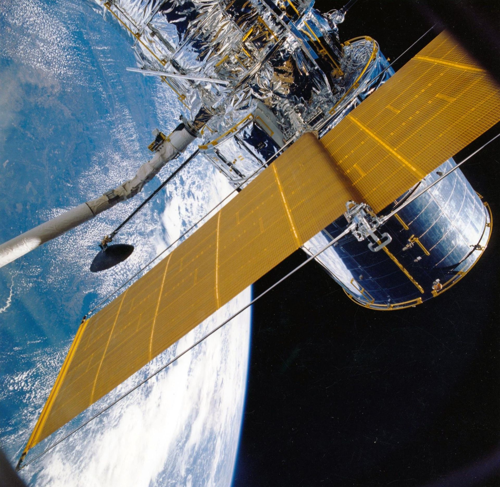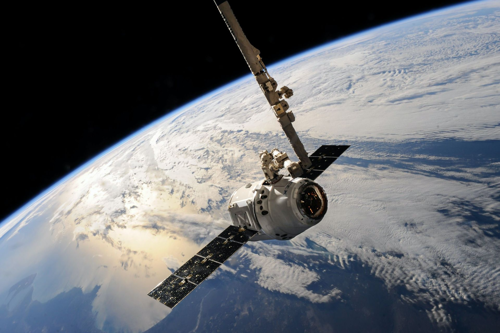
What's Happening in Space: February 2024
- 1st Feb 2024
Exploring Celestial Phenomena and Space Exploration: February Highlights
As we embark on the journey through the celestial wonders and groundbreaking space missions of February, a myriad of fascinating events unfolds in the cosmic calendar. From celestial alignments to monumental space missions, let's delve into the highlights that promise to captivate sky gazers and space enthusiasts alike.
Dhara Patel is here to guide you this month! Dhara works as a Space Expert at the National Space Centre, helping educate people on space science, stories.
Read on for her round-up of some notable space and science events coming up in the weeks ahead...

Early February (1st-12th) – Spot Comet 144P/Kushida
Comet 144P/Kushida is making its seven-yearly visit to the inner solar system but will be ninth-magnitude in February (below the limit of naked-eye visibility). Therefore, it will be best observed using a small telescope or larger-format binoculars. The comet is ideally placed for Northern Hemisphere observation and will be easier to find between 1st-10th February as it passes through the constellation of Taurus. And as a bonus comet Kushida will pass by the Hyades star cluster around the eye of the bull (denoted by the star Aldebaran). On 4th / 5th February the comet passes close to Gamma Tauri (the star at the pointed end of the ‘V’ shape formed by the main stars in the Hyades cluster). The comet will become dimmer as it continues along the arm of the Hyades ‘V’ shape over the next few days, passing very close to the bright red star Aldebaran on 10th February. Look for Taurus high up in the south-western around 9:00pm. The comet should be visible as a pale grey patch in good binoculars while astrophotography will show the greenish glow typical of comets.
6th February – NASA’s PACE mission launches
NASA’s PACE (Plankton, Aerosol, Cloud, ocean Ecosystem) mission is set to acquire data will help us better understand how the ocean and atmosphere exchange carbon dioxide. This Earth-observing satellite will help advance our understanding and observations of global ocean colour, biogeochemistry, and ecology, along with the carbon cycle, aerosols, and clouds. It’s due to launch just after 6:30am on 6th February atop a Falcon 9 rocket from Cape Canaveral with a minimum mission duration of three years (but with orbit maintenance capabilities of 10 years).
7th February – close approach / conjunction of the Moon and Venus
During the evening of 7th February the waning crescent moon will be in conjunction (sharing the same right ascension – coordinate) with Venus. However, at the time of conjunction, the moon and Venus will be below the western horizon. So instead look for the pair in close approach earlier on that day in the south-eastern sky around 7:30am before the sun rises. They’ll be close to the horizon so you’ll need a clear view with no tall trees and buildings to block your view. They’ll be visible to the naked eye but will be too widely separated to be seen together through a pair of binoculars or within the field of view of a telescope. Find out more about how to see these astronomical phenomena and what telescopes would be great to observe them in our blog created by our Education Team: Space Telescopes.
9th February – new moon (10:59pm)
The new moon on 11th will occur in the constellation of Capricornus. To learn more about the Moon then please see our blog created by our Space Comms team: The Dark Side of the Moon.
11th February – close approach / conjunction of the Moon and Saturn
Just after midnight on 11th February, the extremely thin waxing crescent moon will be in conjunction (sharing the same right ascension – coordinate) with Saturn. At the time of conjunction, the moon and Saturn will be below the western horizon. So instead look for the pair in close approach on the evening of 11th February in the south-western sky when the sun begins to set. They’ll be close to the horizon so it’s helpful to have a clear view without tall buildings and trees to view them easily. On the evening of 11th February, they’ll be visible to the naked eye but too widely separated to be seen together through a pair of binoculars or within the field of view of a telescope. Check out the astronomical phenomena blog above to find out more about conjunctions and other astronomical phenomena.
mid-February (14th?) – Intuitive Machines – Mission 1
The Nova-C lunar lander on the IM-1 mission from Astrobotic Technology it set to Launch no earlier than mid-February from Kennedy Space Center, Florida on a Falcon 9 rocket hoping to become the first successful commercial mission to the soft land on the Moon. NASA is working with several American companies to deliver science and technology to the lunar surface through the Commercial Lunar Payload Services (CLPS) program and Intuitive Machines with its Nova-C lander, will carry several NASA and commercial payloads to the lunar surface. The challenges experienced by the Peregrine lander last month and the spate of attempts by others in the past few years shows the difficulty of achieving lunar landing. So if successful, Nova-C (the next attempt from one of NASA’s CLPS initiative) will become the first private spacecraft to land softly on the Moon’s surface.
15th February – close approach / conjunction of the Moon and Jupiter
On the morning of 15th February, the waxing gibbous moon will be in conjunction (sharing the same right ascension – coordinate) with Jupiter. At the time of conjunction (roughly 8:15am), the pair will be just below the eastern horizon. They’ll rise in the daytime sky so won’t be visible until later that day, so look out for the pai in close approach as the sun sets on 15th February. They’ll be nice and high in the south western sky and will remain visible until they set in the west around midnight, though their separation will increase throughout the night. During the evening, they’ll be visible to the naked eye and at a push might be seen together through a pair of binoculars (in the early evening), but will be too far separated to be seen within the field of view of a telescope. Check out the astronomical phenomena blog above to find out more about conjunctions and other astronomical phenomena.

22nd February – close approach / conjunction of the Venus and Mars
On the afternoon of 22nd February, Venus will be in conjunction (sharing the same right ascension – coordinate) with Mars. At this time, both planets will be below the southwestern horizon so won’t be visible but you might be able to catch them in close approach earlier that morning. Look to the southeast around 6:30am, the pair will be very close together and close to the horizon so you’ll need a clear view without any buildings or trees in that direction. Whilst they will be visible to the naked eye and through a pair of binoculars (which might be helpful to spot Mars which will be dimmer), the pair will be too far separated to comfortably be seen within the field of view of a telescope. Check out the astronomical phenomena blog above to find out more about conjunctions and other astronomical phenomena.
24th February – full moon (12:30pm)
Known as the Snow moon (according to the old Farmers’ Almanac), it marks the cold and snowy time of year experienced in North America. Check out the “Full Moon: Full Facts” blog written by Mike Darch in our Space Comms team: https://spacecentre.co.uk/blog-post/full-moon-facts/.
late-February (29th?) – SpaceX Crew-8 launch
The eighth crewed operational flight of a Crew Dragon spacecraft to the International Space Station as part of NASA’s Commercial Crew Program includes NASA astronauts Michael Barratt, Matthew Dominick, and Jeanette Epps along with Alexander Grebenkin from Roscosmos. They are scheduled to launch in late February on board the Crew Dragon Endeavour spacecraft atop a SpaceX Falcon 9 rocket from Kennedy Space Centre. But the date is dependent on the launch of IM-1 (Intuitive Machines Mission 1). If IM-1 launches as planned in mid-February, Crew-8 could fly around 29th February / 1st March. But if IM-1 misses its narrow monthly window (that allows it to reach the Moon when the lighting conditions as optimum for landing), then Cre-8 may not launch until 22nd March (at the earliest). Crew-7 would return home shortly after launch, giving a few days for crew handover. Having launched in August 2023, NASA’s Jasmin Moghbeli, ESA astronaut Andreas Mogensen, JAXA’s Satoshi Furukawa, and Roscosmos cosmonaut Konstantin Borisov will return to Earth on their Crew Dragon spacecraft, Endurance, after a 6-month stint in space.
February?? – ISRO’s Gaganyaan-1 mission
Gaganyaan-1 will be the first uncrewed test flight of the Gaganyaan programme from the Indian Space Research Organisarion (ISRO) and is due to launch from the Satish Dhawan Space Centre on an LMV 3 rocket in February. The aim of the Gaganyaan project is to demonstrate national human spaceflight capability by launching 3 crew members into low Earth orbit (400 km) for a few days and then return them to earth safely. The first demo flight will be an opportunity for technology demonstrations of the spacecraft, as well as safety and reliability checks. It will also have a number of instruments to study the performance of the systems before the first crewed test flight proposed for 2025. The Gaganyaan program will pave the way for India to achieve a sustainable human presence in space.
February?? – Starship – Test Flight 3
Following the first test flight of the fully integrated Starship rocket on 20th April 2023 and a second attempt on 18th November 2023, SpaceX are gearing up for a third test flight. Starship is made of the Super Heavy booster – a first stage rocket with 33 of SpaceX’s raptor engines and on top of that sits the upper stage, rather confusingly also called Starship, which hosts 6 engines. And when its fully developed it will be a completely reusable rocket – both first and second stages. Back in April the upper stage failed to separate from the booster a few minutes into its flight and SpaceX experienced a ‘rapid unscheduled disassembly’ a.k.a. an explosion. In November, the stages separated but shortly after, the first stage had multiple engine failures and after beginning its boost back burn, ended up exploding. Meanwhile the Starship second stage continued to fly for over 8 minutes, but an anomaly caused the flight termination system to kick in, so it too was destroyed after reaching an altitude of 148 km. Having completed a static fire test at the end of 2024 (igniting the engines to test them while the rocket stays bolted to the launch mount), SpaceX are awaiting a launch license for a third test flight to complete their objective of sending a Starship upper stage craft around the Earth before splashing down in the Pacific Ocean near Hawaii, with the Super Heavy first stage coming down in the Gulf of Mexico shortly after launch. Find out more about about upcoming events in Space by checking out our blog written by our Space Communication team: Today in Space
Please note: As this summary is created at the end of the month before, dates (especially launch dates) can often change or be updated, so this content may become outdated - we always recommend checking on the relevant organisation's pages.
